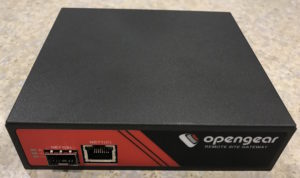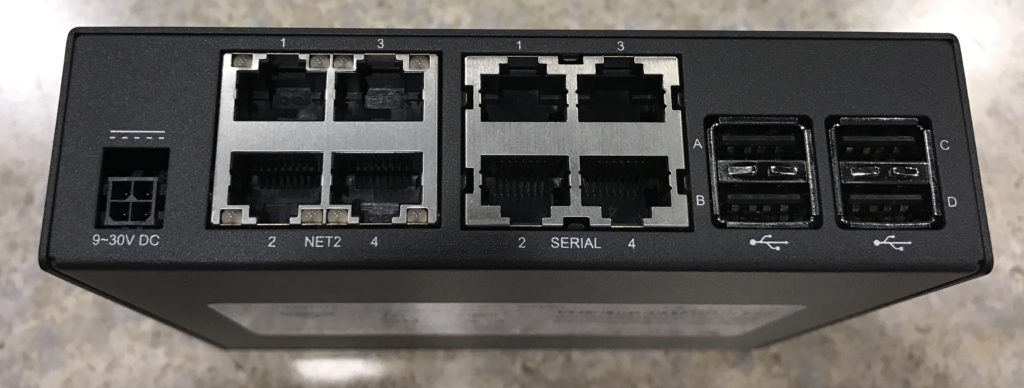Arista’s EOS Redesign Succeeds; it Does Not Infringe on Cisco Patents
 Its redesigned products can be imported into the U.S.
Its redesigned products can be imported into the U.S.
USB Consoling Myself With Opengear’s ACM7004-5
Have you ever tried using the USB Console port on your network hardware? Me neither, and that’s mainly because the instructions typically begin with Download and install the USB console driver for your operating system,
at which point I exhale deeply and get out my USB serial adapter instead. I think Opengear must have heard me sighing because the ACM7004-5 Remote Site Gateway device they’ve sent me to look at has four USB console ports built in.
Opengear ACM7004-5
The compact ACM7004-5 packs more power than its diminutive stature might at first suggest. Taking a look at the back panel reveals a densely-packed set of ports offering a total of four switched GigabitEthernet ports, four serial console ports (RJ-45) and four USB ports:
As with the other small Opengear devices I’ve tested, this model comes with a single rackmount bracket so it can be attached within a rack with relative ease. It’s only about five inches wide, so it’s not too hard to find a free space to locate it. If you aren’t blessed with a rack, there are small rubber feet that can be stuck on the underside. The power port is interesting; I find myself shouting for Continue reading
PowerNSX: PowerShell cmdlets to automate NSX
Looking to automate NSX for vSphere? Unsure where to start? Look no further than PowerNSX.

PowerNSX is a PowerShell module that abstracts the VMware NSX for vSphere API to a set of easily used PowerShell functions. It aims to focus on exposing New, Update, Remove and Get operations for all key NSX functions as well as adding additional functionality to extend the capabilities of NSX for vSphere management beyond the native UI or API.
PowerNSX works closely with VMware PowerCLI, and PowerCLI users will feel quickly at home using PowerNSX. Together these tools provide a comprehensive command line environment to manage your VMware NSX for vSphere environments.
PowerNSX continues to be updated and feature requests are welcome via the issues tracker on the projects GitHub page. Remember that VMware does not support this module, and PowerNSX comes with no warranties express or implied. Please test and validate PowerNSXs functionality before using in a production environment.
What’s in the box?
So what does your free download of PowerNSX give you?
At a glance:
- Over 210 cmdlets providing CRUD operations for a majority of NSX for vSphere’s capability. This command-line environment (programmatic language) allows for projects and applications of all sizes!
- Quickly deploy entire application stacks Continue reading
Worth Reading: High Speed Optical Networking
The post Worth Reading: High Speed Optical Networking appeared first on 'net work.
Network Break 113: Nutanix Targets Networking; More IoT Threats
Todays Network Break episode examines new networking features from Nutanix, the latest in IoT security research, a Google/Intel partnership & more The post Network Break 113: Nutanix Targets Networking; More IoT Threats appeared first on Packet Pushers.OpenStack Becomes a Standard Building Block for NFV
 OpenStack is becoming the de facto standard for infrastructure orchestration for NFV deployment by leading Communications Service Providers (CSPs).
OpenStack is becoming the de facto standard for infrastructure orchestration for NFV deployment by leading Communications Service Providers (CSPs).
FlokiBot: A Flock of Bots?
In early October, Flashpoint released an analysis of an underground forum advertisement for a new malware family known as FlokiBot. It took some time before a sample was found in the wild, but a researcher known as hasherezade flagged one on VirusTotal in early November. […]FlokiBot: A Flock of Bots?
In early October, Flashpoint released an analysis of an underground forum advertisement for a new malware family known as FlokiBot. It took some time before a sample was found in the wild, but a researcher known as hasherezade flagged one on VirusTotal in early November. She also wrote an analysis of its dropper here. This […]Does NFV Create Vendor Lock-In?
 The challenge becomes scalability.
The challenge becomes scalability.

